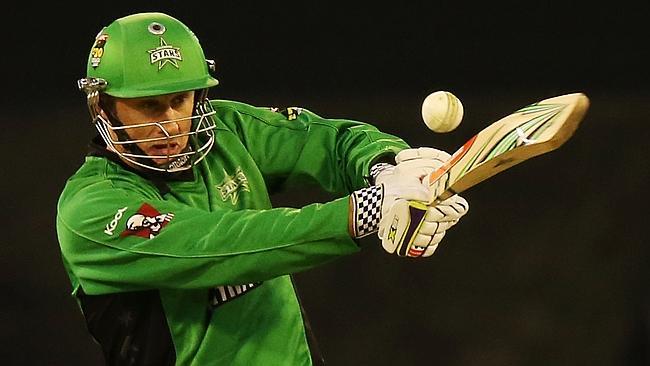Cricket Australia sets the field for a lucrative summer of sport
THE business for Australia’s national summer sport is booming with media groups and sponsors pouring money into its coffers.

Mark Taylor is peddling Fujitsu airconditioners. Steve Waugh is promoting Blooms Chemists. Adam Gilchrist is the face of Suncorp Bank. Glenn McGrath is selling Toyota cars and Ricky Ponting is a Swisse vitamins ambassador.
While these retired cricket greats continue to profit from their sporting careers, the current crop of players are making pots of money on and off the pitch too, spruiking sponsors including Milo, KFC, Commonwealth Bank and Coca Cola. The impressive earning power of the top players is matched by the strong financial position of the sport’s domestic governing body Cricket Australia, which is entering a golden summer with well-lined coffers and a saturated 2014/15 calendar that promises to deliver a record revenue and surplus.
What’s been promoted as the “biggest summer of international cricket held in this country” features 330 days of cricket starting with the one-day and T20 series against South Africa, then a four-Test series against the money-making machine that is India, a tri-series of one-day matches against India and England and ending with the International Cricket Council’s World Cup. The World Cup starts on February 14 and will be played in Australia and New Zealand over six weeks. It features 10 Test playing nations, along with Ireland, Afghanistan, Scotland and the United Arab Emirates. Cricket Australia’s chief executive since 2001 James Sutherland calls the financial windfall and profile boost as a once in a generation opportunity. The World Cup is biggest world sporting event after the Olympics and football’s World Cup in terms of global audience. In 2015 it will also be the biggest sporting event in the world. “On the revenue side we are budgeting for and expecting that this will be the biggest year for us in the history of Australian cricket,” Sutherland says. “Well in excess of $350m is the revenue we are looking at. Because of the teams touring (India and England) it will be a year of significant surplus. We are anticipating it will be our best year ever.”
Because CA’s finances can change dramatically year-on-year, depending on which teams are touring Australia, it calculates is revenue and surplus over a four-year period to smooth out the peaks and troughs. A home Ashes is financial nirvana, but the revenue from a tour in England is negligible. Projected revenue for the current four-year cycle, which takes in the golden summer, is $1.130 billion, rising from $684m in 2009-2012 and $418m for 2004-2008. CA expects the projected surplus for the 2013-2016 cycle will also be a record of $46m, more than triple the previous surplus of $15m in 2009-2012.
Sutherland says that over a four-year cycle 70 per cent of CA’s revenue comes from media partners paying for broadcast rights, 20 per cent from sponsorship and other commercial partners and 10 per cent from ticket sales. “We have a strong foundation not just in a financial sense but with record levels of participation, attendances at matches and TV viewership.” CA’s domestic television partners, the Nine and Ten networks, contribute 65 per cent of total broadcast revenue with international partners Star, BSkyB and Willow paying the lion’s share of the other 35 per cent for the rights to games played in Australia that are broadcast into India, Britain and the US respectively. “We have a bumper year when India tours because the value of the Indian broadcast rights are higher than for any other tour,” Sutherland says. “When India is touring Australia it is a time to be proud because the whole world is watching. The Indian diaspora around the world is phenomenal. Our third biggest overseas broadcast market is the US where the diaspora of Indians and sub continentals want to watch India playing Australia.”
CA’s current financial strength is underpinned by a $550m domestic broadcast deal negotiated with Nine and Ten. In June last year (2013) the two networks signed a five-year deal to broadcast Tests, one-day internationals and the Big Bash League (BBL) on free-to-air TV. Nine agreed to pay $450m for Test and one-day matches and while Ten will pay $100m for the Twenty/20 BBL format, which is scheduled to air in December-January in prime time to challenge Seven’s tennis season.
CA made a strategic decision two years ago to investing $20m to set up the BBL. It was part of a bid to get women and children involved in the game after research showed cricket was not on the radar of children aged 10-15 or women who found the game puzzling. The plan was to get them hooked on BBL and then get them to trade up to one-day matches and Tests and nurture a life long interest. CA research shows the strategy to draw new blood is working with 42 per cent of spectators attending their first BBL game. To help negotiate its landmark broadcast deal with Nine and Ten, CA created a sub committee made up of chairman Wally Edwards and two independent board directors Jacquie Hey, a former Ericsson chief executive and CA’s first female director and mining executive David Peever, the former managing director of Rio Tinto Australia and now deputy chairman of CA. In 2012 Sutherland reformed CA’s board, reducing it from 14 state-based delegates to nine more independent directors free of formal state ties. “They (the sub committee) brought skills, knowledge and expertise to the table as we worked through a challenging negotiation with complex legal and other issues,” Sutherland says.
The domestic broadcast deal delivered “a level of certainty and confidence about our revenues”. “It was a significant uplift from where we were in the pervious arrangement with Nine and FoxSport,” Sutherland says. “It gives us comfort as we invest in the game and help the game to grow.” Being a not-for-profit organisation, Cricket Australia is obliged to reinvest any surplus in its core activities. Part of CA’s strategy to build its grassroots and participation is to ensure its players are the best paid in Australia, compared to other sports. About 26 per cent of total revenue goes in player payments.
The top players including Test and one-day captain Michael Clarke, fast bowler Mitchell Johnson, opening batsman David Warner, bowler Ryan Harris and wicketkeeper Brad Haddin earn about $2m a year before personal endorsements. That $2m is made up of a $1m retainer, plus match payments, bonuses and marketing payments. “It is important we pay them well and what they deserve,” Sutherland says. “Their profile in summer is significant but with profile comes scrutiny and pressure. We know how challenging their role is in terms of performance and expectation. We are proud how we have continued to increase payments to our players. Australian cricket players are the highest paid domestic athletes in the country. It makes cricket a viable career choice for talented young athletes.”
The top-ranked women players including captain Meg Lanning and all-rounder Ellyse Perry earn about $70,000 a year, made up of a $52,000 retainer plus match payments. While the women are paid less than one tenth of the men’s payments, Sutherland says the plan was to lift the women to the same level as the men. “It (women’s pay) is reasonably insignificant compared to men of a similar ilk and it is something we want to increase,” he says. “We see ourselves as being on the pathway to totally professionalising women’s cricket. At the moment we have increased payments to women that allow them greater flexibility and comfort to dedicate more time to their sport. But it is part of the journey for us to continue to increase that in time. We need to be a sport for all Australians and that’s boys and girls, men and women. We have a really strong focus on making cricket a more attractive and welcoming sport for females, not just for players but for fans, spectators and TV viewers.”
Sponsorship is CA’s second biggest revenue driver. While Channel Nine has been associated with cricket since 1979, CA’s main sponsors are also rusted on. Commonwealth Bank has been a sponsor since 1988, Milo since 1992, Carlton and United Breweries since 1993 and Qantas and Gatorade came on board in the early 2000s. “We have a sharp focus on retention of sponsors and we are fortunate to have some of Australia’s best blue chip brands,” Sutherland says. “We pride ourselves on the longevity of our sponsorship agreements.”
In a world where consumers have the attention span of politicians, where politicians speak in 140-character sound bites and where everyone wants everything faster, shorter and yesterday, a game that takes anywhere between a few hours to five days is appealing to sponsors because of the length of time they get to saturate a national audience with their message. It also makes the players familiar household names and trusted brands in their own right. BRW’s list of top 20 Australian sports earners for 2013 includes three cricketers with healthy sponsorship portfolios. The list features all rounder Shane Watson at No 6 with $6m in earnings, No 7 captain Michael Clarke with $5.5m and No 12 batsman David Warner $3.8m.
Sutherland is proud that Australia’s cricketers are on advertisers’ speed dials. “You can pick a Rugby League or AFL player and even if they are the highest profile they won’t have the same cut through as an Australian cricketer has across the nation,” Sutherland says. “The recognition and synergy that Australian cricketers provide, present and past players, is really valuable for sponsors. Cricket is the sight and sound of summer and such an integral part of the Australian way of life. It is a constant. It has a nice cadence about it. An over lasts for four to five minutes and then there is a 30 second break and we all know what happens in that 30-second break.”
SCORECARD
Cricket Australia’s balance sheet is on a good wicket thanks to astute marketing.
Revenue: Cricket Australia’s revenue rose 63 per cent to $684 million over cricket’s four-year Reporting cycle of 2009-2012, up from $418m previously. Projected revenue for next four-year cycle is a record $1.13 billion.
Surplus: $46 million. The projected surplus is more than three times the previous four-year cycle amount of $15m in 2009-2012.
Participation: 1.106 million. Australians participated in cricket during 2013-14, an increase of 16 per cent on the previous year. 537,000 were school participants, 400,000 from clubs and community and 169,000 indoor players; 247,000 females participated, a 39 per cent increase on the previous period.
Audience: Total cricket attendances were 1.73 million in 2013-14, including 650,000 spectators at Big Bash League (T20) matches. The biggest BBL crowd was 42,837 at a Melbourne Renegades v Melbourne Stars match. The average Network Ten audience for the BBL matches
was more than 930,000. The 2013 Boxing Day Test set a world record for the largest crowd attending a single day of cricket: 91,112.
Golden summer: The 2014-15 summer will be the biggest in Australian cricket history with 330 days of international and domestic cricket being played. It starts with matches against South
Africa, then India and England and concludes with the ICC Cricket World Cup, which will be hosted by Australia and New Zealand. More than one million spectators and one billion on global TV will watch 49 matches over 44 days in 14 cities. The final is at the MCG.
Digital strategy: In June 2013 Cricket Australia established a $60 million joint venture with Nine Entertainment Company to establish its own digital media team to service cricket.com.au, social media channels and Cricket Australia Live, the offi cial app which live streams all internationals played at home and all BBL matches. The app had more than one million downloads and recorded more than 28 million visits between November 2013 and March 2014.


